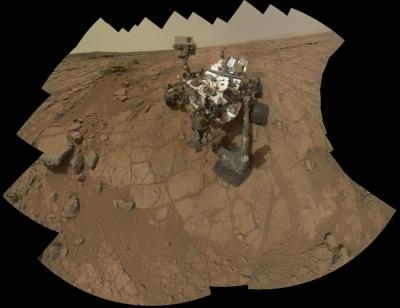Thu, Oct 31, 2013
Completes First Two-Day Autonomous Drive
NASA's Mars rover Curiosity completed its first two-day autonomous drive Monday, bringing the mobile laboratory to a good vantage point for pictures useful in selecting the next target the rover will reach out and touch. When it drives autonomously, the rover chooses a safe route to designated waypoints by using its onboard computer to analyze stereo images that it takes during pauses in the drive. Prior to Monday, each day’s autonomous drive came after a segment earlier that day that was exactly charted by rover team members using images sent to Earth. The Sunday-Monday drive was the first time Curiosity ended an autonomous driving segment, then continued autonomously from that same point the next day.

The drives brought Curiosity to about 262 feet (about 80 meters) from "Cooperstown," an outcrop bearing candidate targets for examination with instruments on the rover's arm. The moniker, appropriate for baseball season, comes from a named rock deposit in New York. Curiosity has not used its arm-mounted instruments to examine a target since departing an outcrop called "Darwin" on Sept. 22. Researchers used the arm's camera and spectrometer for four days at Darwin; they plan to use them on just one day at Cooperstown.
Starting to use two-day autonomous driving and the shorter duration planned for examining Cooperstown serve to accelerate Curiosity's progress toward the mission's main destination: Mount Sharp.
In July, Curiosity began a trek of about 5.3 miles, starting from the area where it worked for the first half of 2013, headed to an entry point to Mount Sharp. Cooperstown is about one-third of the way along the route. The team used images from NASA's Mars Reconnaissance Orbiter to plot the route and choose a few points of potential special interest along the way, including Darwin and Cooperstown. "What interests us about this site is an intriguing outcrop of layered material visible in the orbital images," said Kevin Lewis of Princeton University, Princeton, NJ, a participating scientist for the mission who has been a leader in planning the Cooperstown activities. "We want to see how the local layered outcrop at Cooperstown may help us relate the geology of Yellowknife Bay to the geology of Mount Sharp."
The team is using images taken from the vantage point reached on Monday to decide what part of the Cooperstown outcrop to investigate with the arm-mounted instruments. The first day of the two-day drive began Sunday with about 180 feet on a southwestward path that rover drivers at NASA's Jet Propulsion Laboratory, Pasadena, CA evaluated ahead of time as safe. The autonomous-driving portion began where that left off, with Curiosity evaluating the best way to reach designated waypoints ahead. The vehicle drove about 125 feet autonomously on Sunday. "We needed to store some key variables in the rover's non-volatile memory for the next day," said JPL rover driver John Wright. Curiosity's volatile memory is cleared when the rover goes into energy-conserving sleep mode overnight.
The stored variables included what direction the rover was driving when it ended the first day's drive, and whether it had classified the next 10 feet in that direction as safe for driving. When it began its second day of driving, Curiosity resumed evaluating the terrain ahead for safe driving and drove 105 feet, all autonomously. This new capability enables driving extra days during multi-day activity plans that the rover team develops on Fridays and before holidays.

A key activity planned for the week of Nov. 4 is uploading a new version of onboard software -- the third such upgrade since landing. These upgrades allow continued advances in the rover's capabilities. The version prepared for upload next week includes, for example, improvements in what information the rover can store overnight to resume autonomous driving the next day. It also expands capabilities for using the robotic arm while parked on slopes. The team expects that to be crucial for investigations on Mount Sharp.
JPL, a division of the California Institute of Technology in Pasadena, manages the Mars Science Laboratory Project for NASA's Science Mission Directorate, Washington. JPL designed and built the project's Curiosity rover.
(Images provided by NASA)
More News
Aviation Governance Secured...At Least For a While The National Business Aviation Association similarly applauded the passage of the FAA's recent reauthorization, contentedly recou>[...]
Emphasis On Growing The Future of Aviation Through Concentration on 'AFFORDABLE FLYERS' It's been a number of years since the Latest Edition of Jim Campbell's HUGE SportPlane Resou>[...]
Amazilia Aerospace GmbH, Develops Digital Flight Control, Flight Guidance And Vehicle Management Systems Textron eAviation has acquired substantially all the assets of Amazilia Aer>[...]
Honeywell's Primus Brings New Tools and Niceties for Hawker Operators Hawker 4000 business jet operators have a new installation on the table, now that the FAA has granted an STC f>[...]
Company Celebrates Niche-but-Important Advancement in Industry Standards Echodyne has announced full integration of its proprietary 'EchoFlight' radar into the e American Aerospace>[...]
 Bolen Gives Congress a Rare Thumbs-Up
Bolen Gives Congress a Rare Thumbs-Up The SportPlane Resource Guide RETURNS!!!!
The SportPlane Resource Guide RETURNS!!!! Buying Sprees Continue: Textron eAviation Takes On Amazilia Aerospace
Buying Sprees Continue: Textron eAviation Takes On Amazilia Aerospace Hawker 4000 Bizjets Gain Nav System, Data Link STC
Hawker 4000 Bizjets Gain Nav System, Data Link STC Echodyne Gets BVLOS Waiver for AiRanger Aircraft
Echodyne Gets BVLOS Waiver for AiRanger Aircraft




